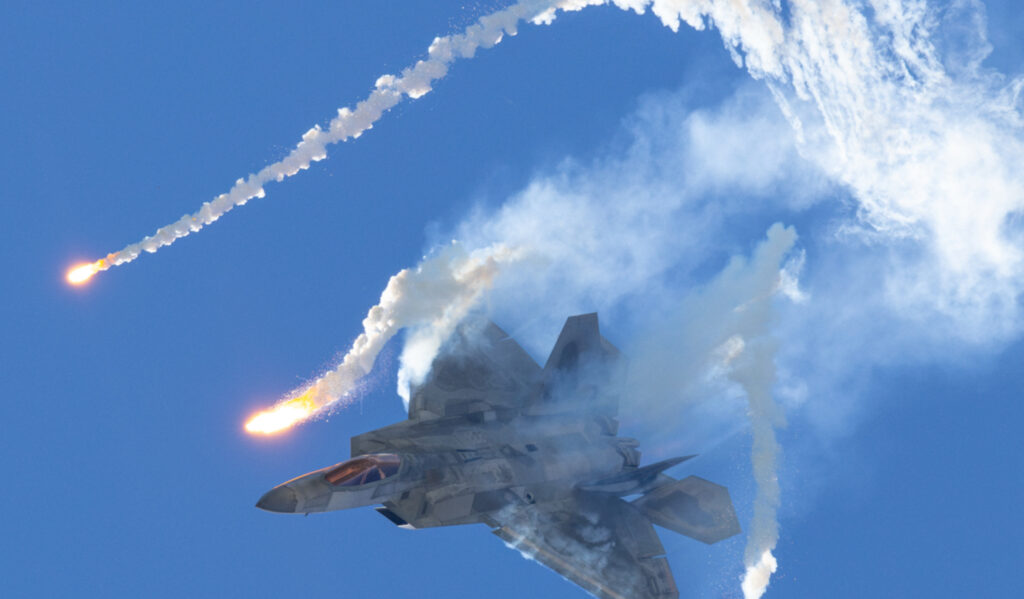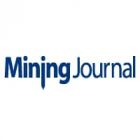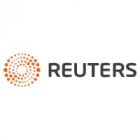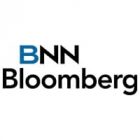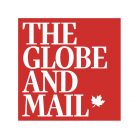To put the importance of titanium in context, the F-22 air superiority fighter — generally considered the best fighter in the world — uses more titanium than any other US Air Force aircraft, over 9000 lb, or approximately 42% by weight
Titanium is critical across advanced defence and aerospace, as well as the automotive, medical and industrial sectors.
And supply is tightening, just as demand and geopolitical tensions are rising.
What is titanium
Titanium is as strong as steel and 40% lighter, giving it an impressive high strength-to-weight ratio; it also has excellent corrosion resistance, a high-melting point and is non-toxic when used in medical implants.
Titanium ore is a “transition metal”, with titanium-containing minerals mined, then processed to remove impurities and separate the titanium dioxide (TiO₂) which can then be converted (via the energy-intensive Kroll process) into titanium metal and ultimately into titanium sponge which is the first stage in making titanium metal.
- aerospace: titanium is crucial to the manufacture of aircraft frames, engines (including compressor blades, etc), landing gears, etc due to its light-weight strength and heat tolerance
eg titanium accounts for 15% of a Boeing Dreamliner’s weight, using about 50 tons for each plane - defence: as well as aircraft, titanium is used across a range of naval and military applications, armour and missile casings
- medical: across orthopaedic implants (eg joint replacements), dental implants, surgical instruments, prosthetics, heart stents, and spinal rods due to its biocompatibility and corrosion resistance
- automotive: titanium is increasingly used in high-performance components such as exhaust systems, drive shafts, steering mechanisms, valve springs, and connecting rods to improve speed, efficiency, and reduce weigh
- industry and chemical processing: titanium’s corrosion resistance is deployed in reactors, heat exchangers, and piping systems, particularly when handling aggressive chemicals

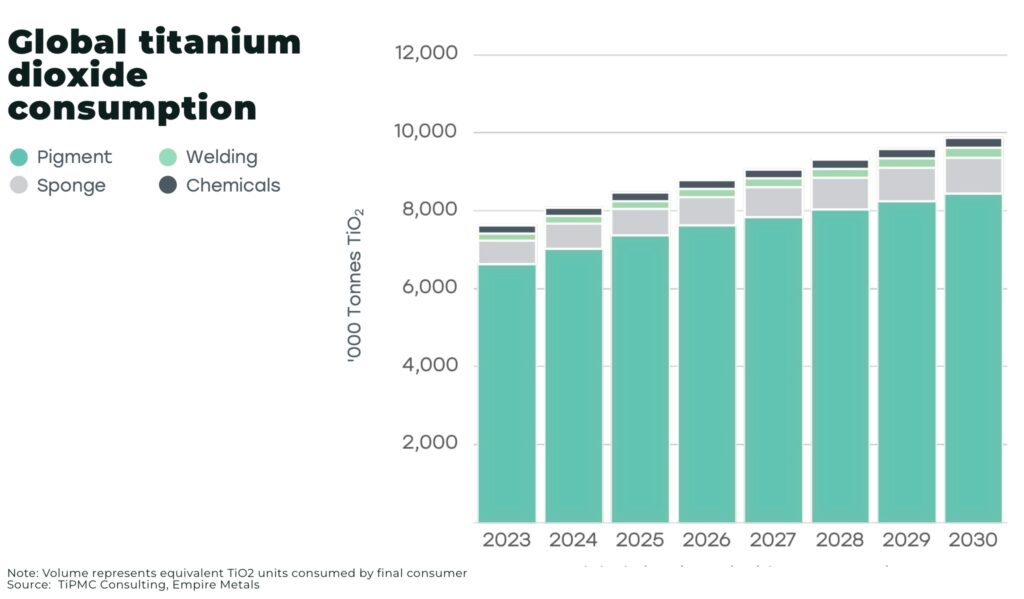
Demand
The global titanium dioxide market is forecast to grow at a compound growth rate of 3.7% from 2023-2030
The two major markets sectors are aircraft production and industrial applications, making up 85% of global demand. However, it must be noted, there are significant regional demand variations with civil aerospace in Europe, for example, accounting for two thirds of titanium metal consumption, while industrial applications account for 29%.
- aerospace: global passenger traffic is projected to surpass 10 billion passengers in 2025, according to electronic payments company ACI World. That figure is up 6% from 2024 and up more than 16% from 2019.
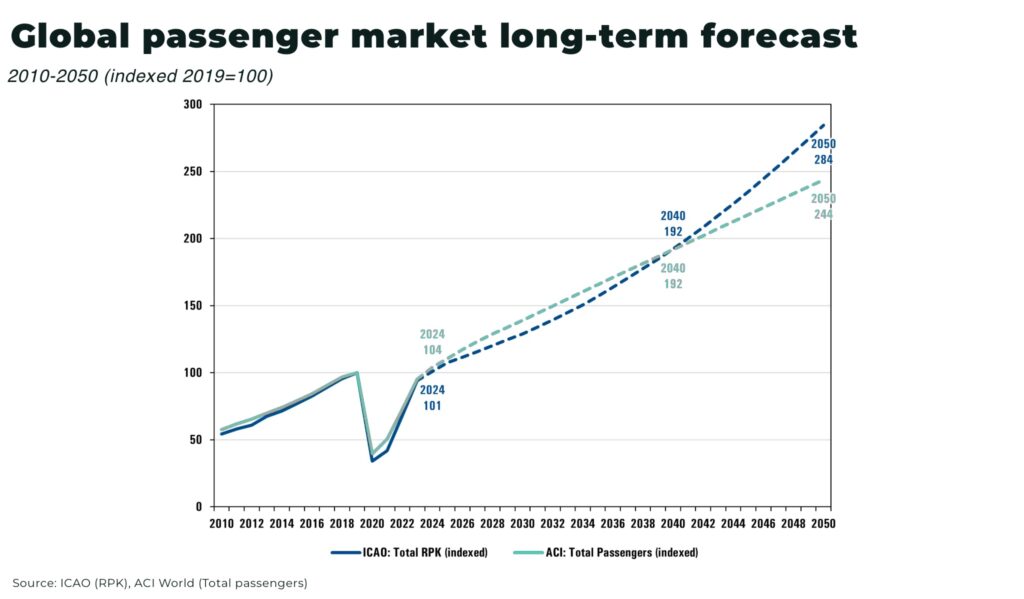
- defence: global defence spending hit USD2.46 trillion in 2024 — with the 7.4% real-terms increase outpacing increases of 6.5% in 2023 and 3.5% in 2022 — and is expected to increase further in 2025 as geopolitical tensions continue to rise
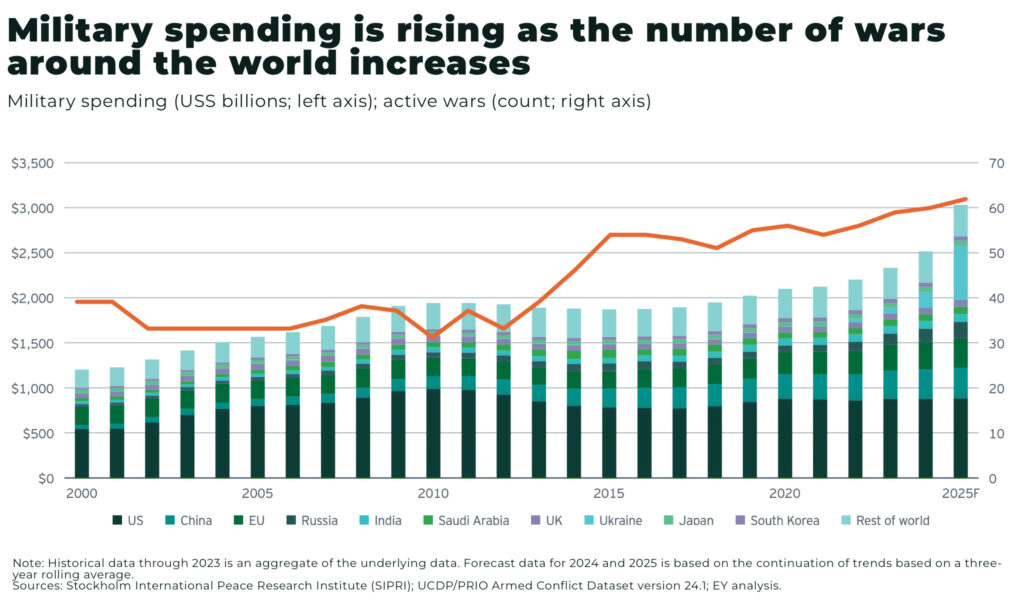
And new technological breakthroughs, for example, new Japanese solar panel technology that use layers of titanium and selenium in the photovoltaic cells promises to boost efficiency by x1000.
Titanium supply
China is the world’s largest producer of titanium minerals, with mine production of ilmenite reaching about 3.3 million metric tons of titanium dioxide content in 2024, nearly doubling the production of Mozambique, the second-largest titanium producer worldwide.
The countries with the highest production of titanium are China (34%), Mozambique (17.5%) and South Africa (12%), while the most abundant reserves are found in Australia, China and India.
But China dominates the global titanium sponge processing industry, increasing capacity nearly x3 from 2018-2023, from 37%
China has come to dominate the global titanium sponge industry with a remarkable expansion of its production capacity since 2018, increasing x3 between 2018-2023, from a 37% share of global output in 2018 to 66% in 2023, as well as the largest titanium ore resources in the world — although the majority of titanium sponge from China is not qualified for aerospace.
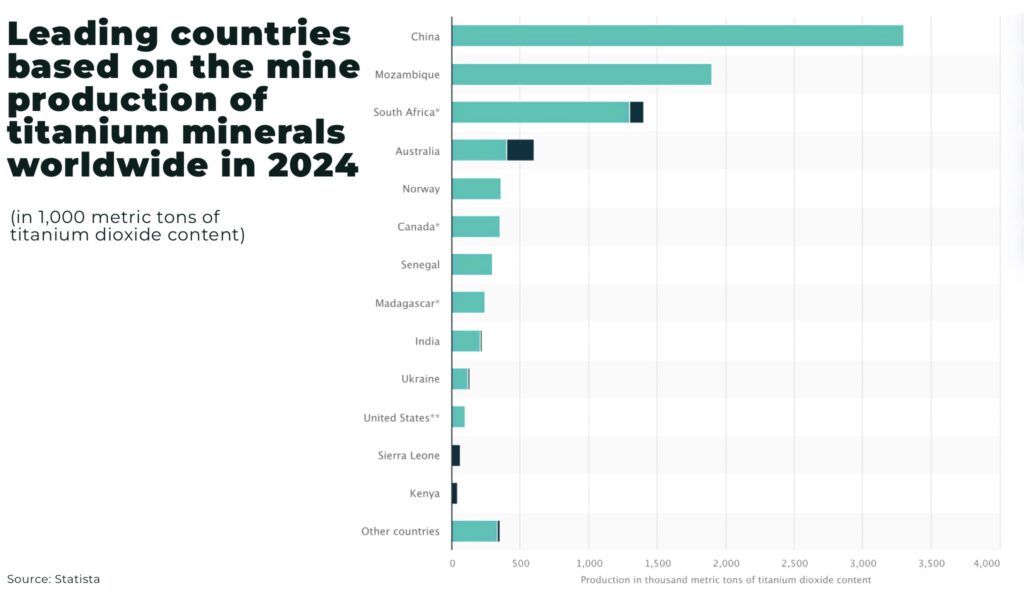
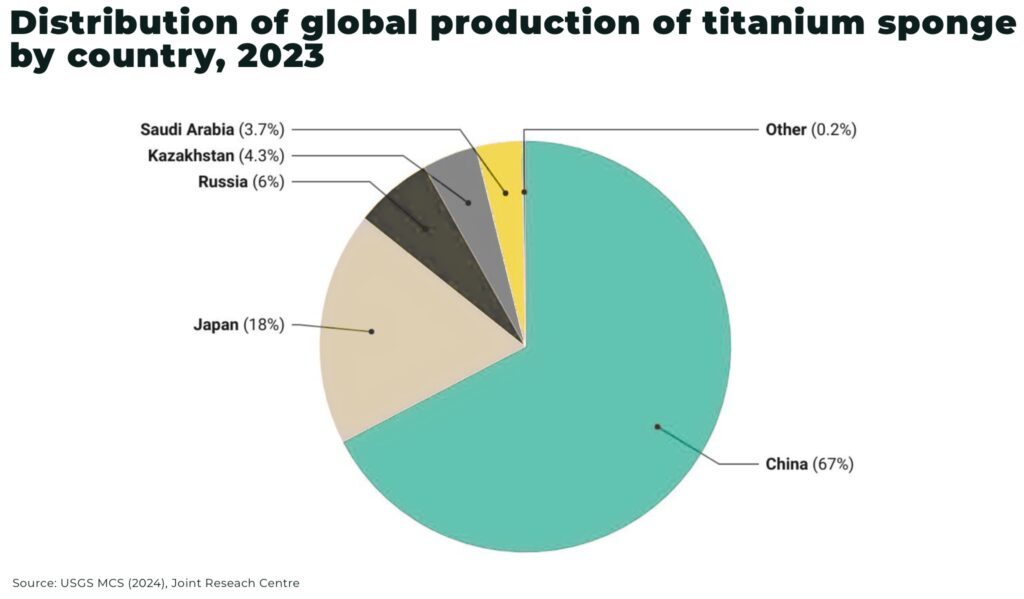
Titanium supply crisis for the West
As demand for titanium surges, so too has the US and EU’s exposure to supply vulnerabilities, for example:
- there is only one titanium sponge metal producer in the US, a facility in Utah producing just 500 tons per year
- withheld to avoid disclosing company proprietary data. The facility in Salt Lake City, UT, w
- the EU does not produce titanium sponge and is 100% reliant on imports
Highlighting the importance and vulnerability of the West’s titanium supply — despite 82% of titanium sponge used in the US comes from Japan — exports from Russia have not been sanctioned by the West since the invasion of Ukraine with an estimated US$345 million worth of titanium exported in 2023 alone.
China’s increasing implementation of export restrictions across a range of critical minerals, from tungsten to antimony, gallium to germanium, has raised alarms about potential future restrictions on titanium.
Bob Wetherbee, president of Dallas-based ATI, one of the three big producers of US titanium metal, recently told the Washington Post that he believed all of the American titanium producers had seen demand double, but that “the lack of action is having an impact on national security.”
The EU has no domestic production capacity of titanium sponge and is therefore a net importer of titanium metal, with an import-to-export ratio of 10:1. In particular, supply from high-quality deposits in Ukraine have been disrupted due to the war.
Mining opportunities
In 2025, the US Department of Defence (DoD) awarded IperionX (NASDAQ: IPX, ASX: IPX) US$47.1 million in funding to develop a fully-integrated domestic mineral-to-metal titanium supply chain. This is further to a previous DoD award in 2023 of US$12.7 million to increase titanium powder production for defense supply chains.
The renewed interest comes as President Donald Trump has signed an executive order invoking cold war era powers to ramp up critical mineral production across the US — and it’s expected titanium will be prioritized.
However, it’s unlikely that any new supply from the US will be enough by itself in the short-term, providing opportunities for potential supply from mines in jurisdictions with free trade agreements and strong historical alliances with America.
Empire Metals (LON: EEE OTCQB: EPMLF) is accelerating the economic development of its flagship Pitfield project, a world-class, district-scale titanium mineral system in Western Australia, which extends over 40km x 8km x 5km deep making it the largest titanium discovery in the world.
The company’s initial focus is on two key prospects, Cosgrove and Thomas, which have been identified as having thick, high-grade, near-surface, bedded TiO₂ mineralisation, each being over 7km in strike length.
A JORC Exploration Target* for Pitfield was declared in 2024, covering the two initial prospects, and was estimated to contain between 26.4 to 32.2 billion tonnes with a grade range of 4.5 to 5.5% TiO2. Included within the total Exploration Target* is a subset that covers the weathered sandstone zone, which extends from surface to an average vertical depth of 30m to 40m and is estimated to contain between 4.0 to 4.9 billion tonnes with a grade range of 4.8 to 5.9% TiO2.
The Exploration Target* covers an area less than 20% of the overall mineral system at Pitfield which demonstrates the potential for significant further upside.
Preliminary testwork has delivered a high-purity TiO2 product, which assayed at 91.6% TiO2 and was entirely free of any deleterious impurities, providing strong potential for its use in high-quality titanium sponge metal or high-grade titanium dioxide pigment production.
The mine is located in Australia’s mid-West, a Tier One mining jurisdiction with direct access to critical infrastructure:
- existing road/rail network
- proximity to Geraldton Port (150km)
- low-energy processing advantages from weathered cap mineralization (30–40m depth)
Metallurgical bulk sampling underway is now underway ahead of the design of a demonstration plant slated for 2025. Empire is focussed on accelerating the economic development of Pitfield, with a vision to produce a high-value titanium metal or pigment quality product at Pitfield, to realise the full value potential of this exceptional deposit.
*The potential quantity and grade of the Exploration Target is conceptual in nature. There has been insufficient exploration to estimate a Mineral Resource and it is uncertain if further exploration will result in the estimation of a Mineral Resource.
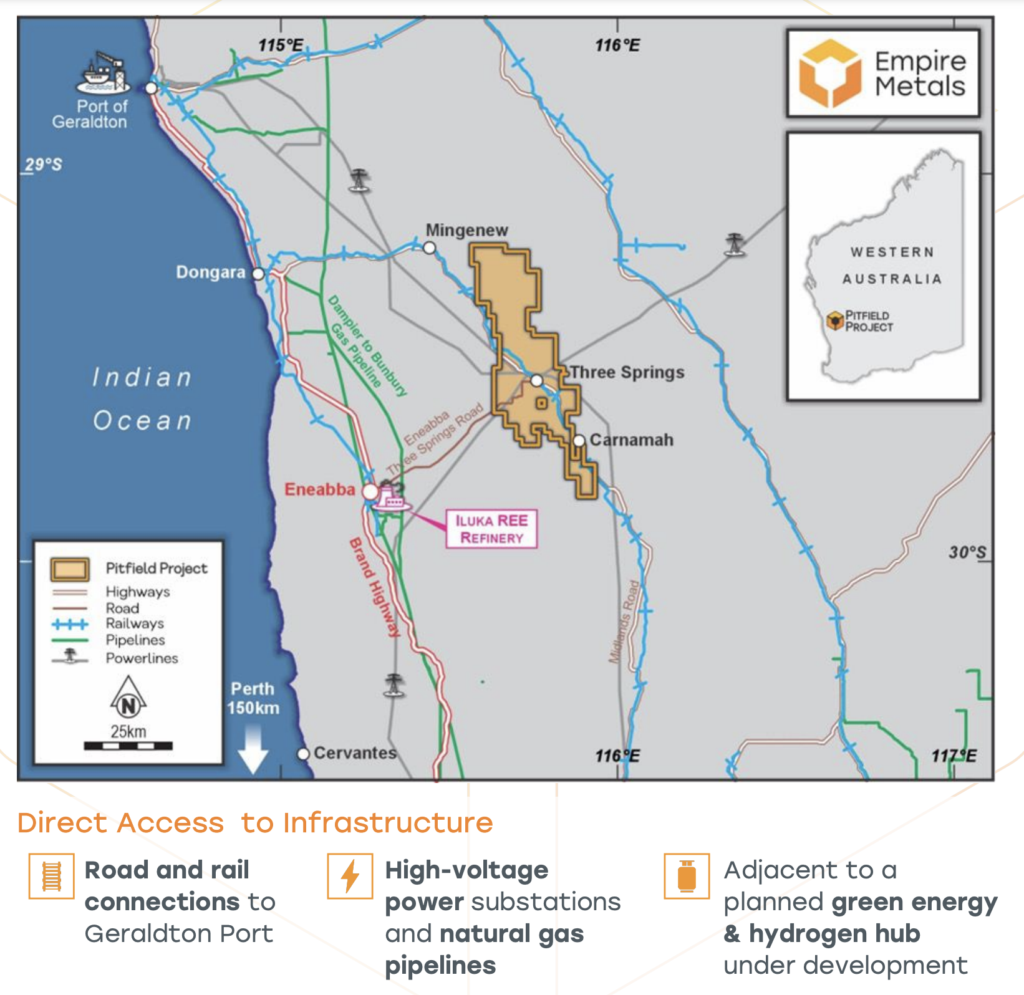
Toho Titanium Co (TYO: 5727): a leading Japanese titanium producer, Toho Titanium has been at the forefront of innovation since 1948. With a production capacity of 12,000 tons/year of titanium sponge and 7,800 tons/year of titanium ingots, Toho is well-positioned to meet growing global demand. Their recent expansion into Saudi Arabia and continuous technological advancements make them a key player in the titanium market.
Osaka Titanium Technologies Co (TYO:5726): the world’s second-largest producer of titanium sponge, Osaka Titanium Technologies is a crucial supplier to the global aerospace industry. Their diversified product portfolio, including high-purity titanium and innovative materials like TILOP (Gas-atomized titanium powder), demonstrates their commitment to meeting evolving market needs. With a strong foundation in the Sumitomo Group, Osaka Titanium is poised for continued growth in the titanium sector.
IperionX (ASX:IPX): this innovative company is revolutionizing the titanium industry with its breakthrough technologies. IperionX’s proprietary processes eliminate the need for titanium metal sponge and ingot, enabling direct manufacturing of titanium products. With recent funding from the US Department of Defense totaling US$59.8 million, IperionX is set to develop a fully-integrated domestic mineral-to-metal titanium supply chain, addressing critical supply vulnerabilities in the West.
Tronox (NYSE:TROX): a leading integrated manufacturer of titanium dioxide pigment, Tronox offers a vertically integrated platform spanning from mine to pigment. Their global operations and focus on sustainability position them as a reliable supplier in the TiO2 market.
Iluka Resources (ASX:ILU): with a strong presence in mineral sands and rare earths, Iluka is a key player in the titanium feedstock industry. Their recent strategic shifts and investments in high-grade deposits underscore their commitment to meeting growing titanium demand.
Kenmare Resources (LON:KMR): is one of the world’s largest producers of titanium minerals with its world-class Moma Titanium Minerals Mine in Mozambique and, in March 2025, rejected a €565m takeover bid from a consortium led by its former MD Michael Carvill. Their strategic position and high-quality mineral deposits make them an attractive investment in the titanium sector.
Sovereign Metals (LON:SVML): with its Kasiya rutile project in Malawi, touted as the world’s largest undeveloped rutile deposit (17.9Mt contained rutile), which is the purest, highest-grade form of titanium feedstock found in nature, Sovereign Metals has the potential to become a significant player in the titanium feedstock market. Their focus on sustainable, low-cost production methods adds to their appeal.
SAGA Metals Corp (TSXV:SAGA OTCQB:SAGMF) is strategically positioned to capitalize on the green energy transition with its Radar Titanium-Vanadium (Ti-V) Project in Labrador’s Grenville Province. This underexplored region, combined with advanced geoscientific techniques, has revealed a robust orthomagmatic Fe-Ti-V system with impressive surface sample results, including titanium dioxide values peaking at 11.1% and vanadium pentoxide up to 0.66%. Initial drilling confirms significant magnetite-rich layering, with over 2,200 meters drilled to date.
The Radar Project’s location near Rio Tinto’s Lac Tio Mine—the world’s largest solid ilmenite deposit—and SAGA’s existing joint venture with Rio Tinto on its Legacy Lithium Project, enhance its strategic appeal. As titanium dioxide sees growing demand for applications like high-efficiency solar panels and as a pigment, SAGA’s Radar Project could become a crucial North American source. With assay results pending and further exploration planned, SAGA Metals is poised to potentially unlock a major new Titanium-Vanadium discovery in a mining-friendly jurisdiction with established infrastructure.
Conclusion
The global titanium market faces intensifying supply-demand tensions as structural deficits emerge across aerospace, defense, and green technology sectors.
This issue is not confined to the long term: spot prices spiked 18-22% year-over-year in Q1 2025, driven by Chinese export restrictions and disruptions in Russian supply chains.
These strategic vulnerabilities are accelerating industry realignments at an unprecedented pace. Trump’s latest tariffs underscore how swiftly geopolitical tensions are reshaping markets and supply chains.
When military capabilities are jeopardized by weaknesses in critical mineral supplies, investment inevitably follows.
